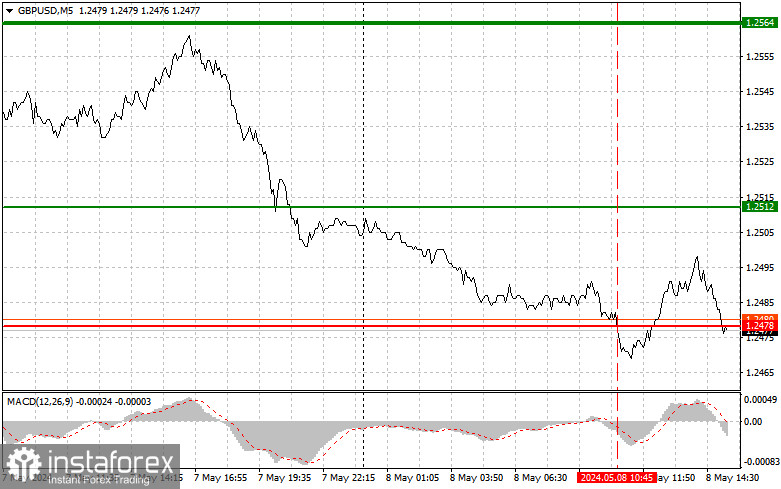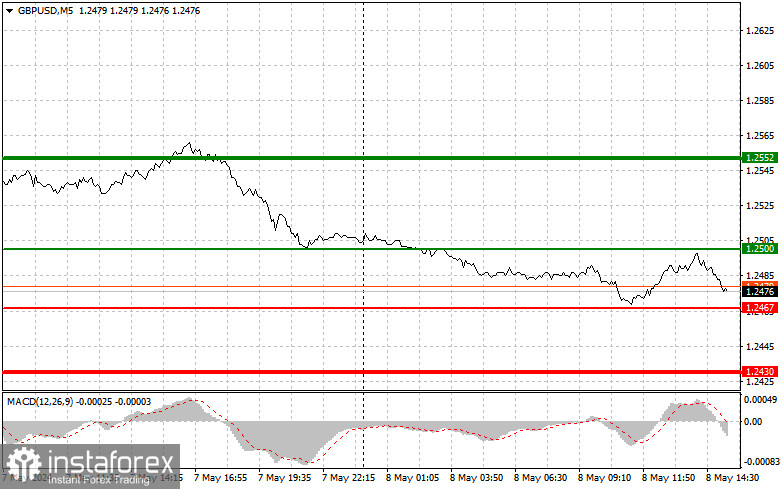Trade analysis and tips for trading the British pound
The test of the price at 1.2478 occurred at a moment when the MACD indicator had significantly declined from the zero mark, which limited the downward potential of the pair. For this reason, I didn't sell the pound, and it turned out to be correct. After dropping about 13 points, demand for GBP/USD returned the pair to the sideways channel. The absence of data and a sharp decline during Asian trading limited the downward potential of the pair. In the second half of the day, attention should be paid to the figures on changes in wholesale inventories in the US, although they are unlikely to lead to a spike in volatility. For this reason, it's best to act within the channel. As for the intraday strategy, I plan to act based on the implementation of Scenario #2, as I don't expect strong movements.

Buy signal
Scenario #1: Today, I plan to buy the pound when the entry point reaches around 1.2500 (green line on the chart), with the goal of rising to the level of 1.2609 (thicker green line on the chart). At around 1.2552, I will exit purchases and open sales in the opposite direction (targeting a movement of 30-35 points in the opposite direction from the level). Today, the rise of the pound can be expected only after weak US statistics and a breakthrough of the daily maximum. Important! Before buying, make sure that the MACD indicator is above the zero mark and is just starting to rise from it.
Scenario #2: I also plan to buy the pound today in case of two consecutive tests of the price at 1.2467 when the MACD indicator is in oversold territory. This will limit the downward potential of the pair and lead to a reversal of the market upward. One can expect a rise to the opposite levels of 1.2500 and 1.2552.
Sell signal
Scenario #1: Today, I plan to sell the pound after the level of 1.2467 is updated (red line on the chart), which will lead to a rapid decline in the pair. The key target for sellers will be the level of 1.2430, where I will exit sales and also immediately open purchases in the opposite direction (targeting a movement of 20–25 points in the opposite direction from the level). Sellers will show themselves in case of a lack of activity around the daily maximum and strong US data. Important! Before selling, make sure that the MACD indicator is below the zero mark and is just starting to decrease from it.
Scenario #2: I also plan to sell the pound today in case of two consecutive tests of the price at 1.2500 when the MACD indicator is in overbought territory. This will limit the upward potential of the pair and lead to a reversal of the market downward. One can expect a decline to the opposite levels of 1.2467 and 1.2430.

On the chart:
Thin green line - entry price, at which the trading instrument can be bought.
Thick green line - the expected price where Take profit can be placed, or profits can be fixed independently, as further growth above this level is unlikely.
Thin red line - entry price at which the trading instrument can be sold.
Thick red line - the expected price where Take profit can be placed or profits can be fixed independently, as further decline below this level is unlikely.
MACD indicator. When entering the market, it's important to consider overbought and oversold zones.
Important. Beginner traders in the forex market should be very cautious when making entry decisions. It's best to stay out of the market before important fundamental reports are released to avoid being caught in sharp exchange rate fluctuations. If you decide to trade during news releases, always place stop orders to minimize losses. You need to place stop orders to avoid losing your entire deposit, especially if you don't use money management and trade with large volumes.
Remember, for successful trading, you need to have a clear trading plan similar to the one presented above. Spontaneous trading decisions based on the current market situation are initially a losing strategy for an intraday trader.
 English
English 
 Русский
Русский Bahasa Indonesia
Bahasa Indonesia Bahasa Malay
Bahasa Malay ไทย
ไทย Español
Español Deutsch
Deutsch Български
Български Français
Français Tiếng Việt
Tiếng Việt 中文
中文 বাংলা
বাংলা हिन्दी
हिन्दी Čeština
Čeština Українська
Українська Română
Română

